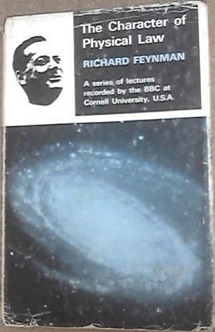 First edition | |
| Author | Richard Feynman |
|---|---|
| Language | English |
| Subject | Physics |
| Genre | Non-fiction |
| Published | 1965 (BBC) |
| Publication place | United States |
| Pages | 173 pp. |
| ISBN | 0679601279 |
| LC Class | QC71 .F44 |
| Website | feynmanlectures |
The Character of Physical Law is a series of seven lectures by physicist Richard Feynman concerning the nature of the laws of physics. Feynman delivered the lectures in 1964 at Cornell University, as part of the Messenger Lectures series. The BBC recorded the lectures, and published a book under the same title the following year; [1] Cornell published the BBC's recordings online in September 2015. [2] In 2017 MIT Press published, with a new foreword by Frank Wilczek, a paperback reprint of the 1965 book. [3]